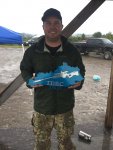I don't know how you would true at 800 with BC when it comes up 4.8 mils with either one listed. If they are the same, what are you truing?
I re-ran it with all the inputs on JBM, exactly as listed on the JBM table shown in post #58. At 800 yards, with the listed speed of 2900fps and all other inputs identical, It is 4.8 mils with a .583 G1 and 4.8 mils with a .595 G1.
So, near as I can figure, Frank had to be talking about the rest of the trajectory.
I'm not sure where .595 G1 came from but this was what I got using other software and the inputs supplied
Cold Bore Desktop *AJ off *no azimuth supplied
AB G7 .294
800=4.8 1000 = 6.9 1350=11.7 1500 =14.2
AB G1 .575
800=4.9 1000 = 7.1 1350=12.0 1500 =14.6
Prime G7 .289
800=4.9 1000 = 7.0 1350=11.8 1500 =14.4
Prime G1 .583
800=4.9 1000 =7.0 1350=11.9 1500 =14.5
using the modified G1 BC .595 lined up at 800
800=(4.8) 1000 =
(7.0) 1350=11.7 1500 =14.2
using modified G1 BC .610 lined up at 1350
800=(4.8) 1000 =(6.9) 1350=
11.5 1500 =13.9
using modified G7 BC .302 lined up at 1350
800=(4.8) 1000 =(6.9) 1350=
11.5 1500 =13.9
TRASOL (Cold Bore Engine) *no azimuth supplied
AB G7 .294
800=4.82 (4.8) 1000 = 6.93 (6.9) 1350=11.71 (11.7) 1500 =14.17 (14.2)
AB G1 .575 lined up at
800=4.88 (4.9) 1000 = 7.06 (7.1) 1350=12.0 (12.0) 1500 =14.6 (14.6)
Prime G7 .289
800=4.85 (4.9) 1000 = 6.99 (7.0) 1350=11.84 (11.8) 1500 =14.37 (14.4)
Prime G1 .583
800=4.86 (4.9) 1000 =7.01 (7.0) 1350=11.89 (11.9) 1500 =14.43 (14.5)
using the modified G1 BC .595 lined up at
800=4.82(4.8) 1000 =6.94 (6.9) 1350=11.73 (11.7) 1500 =14.19 (14.2)
modified G1 BC .612 lined up at 1350
800=4.77 (4.8) 1000 =6.85 (6.9) 1350=11.53 (11.5) 1500 =13.88 (13.9)
modified G7 BC .302 lined up at 1350
800=4.77 (4.8) 1000 =6.85 (6.9) 1350=11.52 (11.5) 1500 =13.87 (13.9)
Applied Ballistics (Kestrel 5700 Elite) *AJ off (WS2) *no azimuth supplied DOF=000
AB CDM (Norma 130 Diamond)
800=4.80 (4.8) 1000 = 6.89 (6.9) 1350=11.50 (11.5) 1500 =13.95 (14.0)
AB G7 .294
800=4.81 (4.8) 1000 = 6.90 (6.9) 1350=11.48 (11.5) 1500 =13.91 (13.9)
AB G1 .575
800=4.85 (4.9) 1000 = 6.96 (7.0) 1350=11.60 (11.6) 1500 =14.04 (14.0)
Prime G7 .289
800=4.84 (4.8) 1000 =6.95 (7.0) 1350=11.61 (11.6) 1500 =14.09 (14.1)
Prime G1 .583
800=4.82 (4.8) 1000 =6.92 (6.9) 1350=11.49 (11.5) 1500 =13.89 (13.9)
*using modified G1 BC .595 lined up at 800
800=4.78 (4.8) 1000 =6.85 (6.9) 1350=11.34 (11.4) 1500 =13.68 (13.7)
Ballistic AE (JBM engine) *no azimuth supplied
AB G7 .294
800=4.81 (4.8) 1000 = 6.91 (6.9) 1350=11.51 (11.5) 1500 =13.95 (14.0)
AB G1 .575
800=4.85 (4.9) 1000 = 6.97 (7.0) 1350=11.62 (11.6) 1500 =14.07 (14.1)
Prime G7 .289
800=4.85 (4.9) 1000 =6.97 (7.0) 1350=11.64 (11.6) 1500 =14.14 (14.1)
Prime G1 .583
800=4.82 (4.8) 1000 =6.92 (6.9) 1350=11.52 (11.5) 1500 =13.93 (13.9)
*using the modified G1 BC .595 lined up at 800
800=4.79 (4.8) 1000 =6.86 (6.9) 1350=11.36 (11.4) 1500 =13.68 (13.72)


